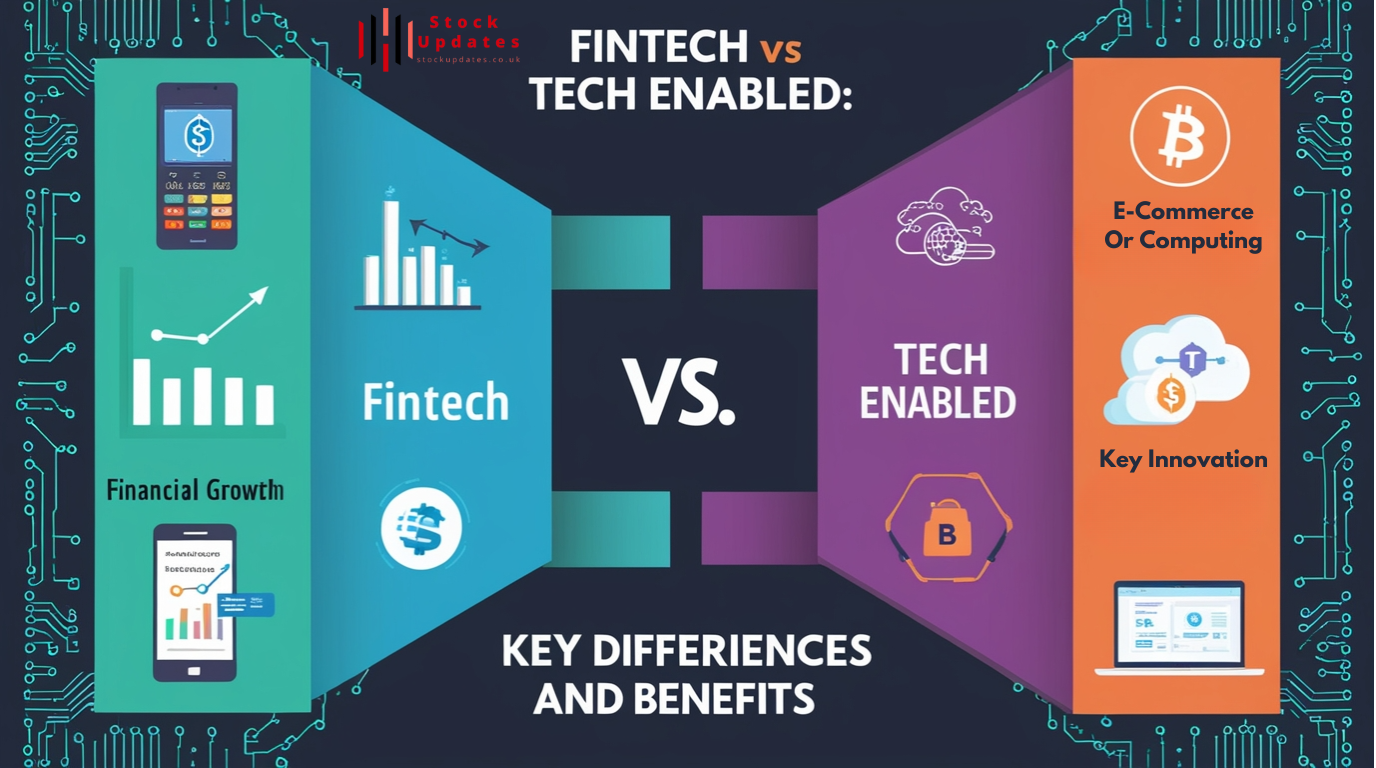Fintech vs Tech Enabled: Key Differences and Benefits
Introduction
In today’s digital world, it is necessary to know what fintech vs tech enabled mean. It defines the way we are going to communicate with financial services and technology. But what do these phrases really mean? How are they different from one another? The article will explore the primary differences and benefits of fintech and tech-enabled solutions, helping guide you in making the best decision.
What is Fintech?

Fintech is short form of financial technology. It describes the wide swathe of technologies that intend to speed and automate the provision of all sorts of financial services. These will run from online banking and mobile payments to investment apps and blockchain technology.
Watch video guide on what is fintech?
Examples of Fintech Companies
Many of the biggest companies in the world are operating within the ambit of the fintech revolution. For example:
- PayPal: It works as an electronic payment system that enables any person with access to the internet to send and receive money.
- Chime: A digital bank offering free-of-charge banking services.
- Robinhood: An investment app where users trade stocks for free of charge.
These companies eliminate the complexity of accessing financial services in terms of ease while offering cheap services.
Core Features and Innovations in Fintech
FinTech’s core focus is placed on a few core features:
- Accessibility: Most companies essentially target disadvantaged communities, so access to banking and other financial services becomes relatively available.
- Speed: Transactions and also approvals take much less time than in the conventional banks.
- User Experience: Fintech applications are designed to be user-friendly for the use of their customers to gain access to their account information.
What Does Tech Enabled Mean?

Tech enabled firms avail the use of technology to exploit existing models of business in diverse industries. These are not companies purely working in finance. They are revolutionizing how things work and are done in different industries.
What Are Examples of Tech Enabled Solutions?
There are many examples of tech enabled solutions across many industries, for instance:
- E-commerce: Companies like Amazon employ technology to make online purchases easy.
- Healthcare: Telemedicine enables patients to consult doctors that are far away.
- Logistics: Apps like Door Dash make food delivery much easier than it used to be.
How Tech Enabled Solutions Help Traditional Businesses
Tech enabled businesses integrate their business operations using the tool known as technology. This yields:
- Improved Efficiency: The set of procedures becomes efficient, saving hours and a lot of expenses
- Good Customer Experience: A user-friendly interface and faster services keep customers satisfied.
- Scalability: Businesses can scale up easily because of technology.
Fintech vs Tech Enabled: What are the key differences?
Knowing about the dissimilarity between fintech vs tech enabled sometimes can help you make the right decision.

Focus Areas in Fintech vs Tech Enabled
The first key focus area is that of their focus. Fintech is focused only on financial services. Fintech focuses on remittances, loan products, savings, etc. Whereas, for Tech-enabled companies, their focus remains on upgrading the existing business process in Finance and other industries, and not limited to finance.
Business Models in Fintech vs Tech Enabled
The business models are also different. Transaction-based revenue is often how fintechs operate, and they get fees on per transaction basis, such as payment processors which is going to take a tiny percentage from each payment. In contrast, tech enabled companies may be using the subscription model that customers pay recurring fee for accessing their services.
Technology Usage in Fintech vs Tech Enabled
Another difference is the way they apply technology. Fintech firms generally build new technologies that better suit financial businesses. For instance, they can develop algorithms for assessing risks in lending. Tech enabled firms, on the other hand, generally resort to applying existing technologies to improve their businesses, such as using cloud services to manage logistics.
Benefits of Fintech
Fintech has brought to shoppers and organizations various benefits that are as per the following:

Enhanced Access to Financial Products
Maybe the main advantage of fintech is better access. Numerous fintech arrangements target individuals who are yet to approach banking and additionally monetary administration. So, this will offer opportunities to those who would have little or no access otherwise.
Customer Experience
Fintech companies focus heavily on the user experience. With a user-friendly app and fast service, all of that puts it easy for customers to manage their finances. Mostly, it increases their level of satisfaction and commitment.
Reduction of Cost to Consumers and Businesses
One of the primary reasons fintech solutions are generally cheaper than traditional banks is lower fees. Consumers get lower transaction costs, while business owners get lower operational costs.
Benefits of Tech Enabled Solutions
Benefits that tech enabled solutions hold are:

Improved Efficiency and Productivity
As far as the advantages of the tech enabled companies, they cut down operations streamlined through technology. This leads to efficient turnaround times and greater productivity, by which businesses can serve their customers better.
Flexibility and Scalability for Businesses
Tech enabled solutions help an organization respond much more easily. Whether it is the need to scale up in peak seasons or to adapt to a newer technology, for example, such organizations can respond to the call of changing market conditions.
Wider Application in Multiple Sectors
Fintechs are not exclusive to finance. They have wider application in various sectors, and each sector experiences various benefits. In healthcare, for example, telehealth solutions have changed the way patients could be managed as there are remote consultations.
The Strategic Value of Tech Enabled Solutions

In this respect, strategic value is delivered through tech-enabled solutions, which are known to bring a lot of operational efficiency and drive digital transformation in a fast-paced manner within all sectors. The business can streamline the processes using advanced technologies such as cloud computing and data analytics, providing valuable insights that inform decisions.
Therefore, this leads to increased productivity while always ensuring customer centrism or the ability for an organization to respond rapidly to a market demand. The more companies opt for tech-enabled solutions, the more they are becoming better adapters since they will be positioning themselves for sustainable growth and competitive advantage in the digital age.
When to choose Fintech vs Tech Enabled Solutions
The right choice is determined by your needs-whether it’s fintech or tech enabled solutions.

Assessing Your Needs
Find out what your requirements are. Are you trying to locate financial services, or do you need to utilize the power of technology for an existing business process? This makes you realize what should be on top of your list of priorities.
Industry Considerations
And then there’s the industry. So, if you are in the banking and financial sector, for example, fintech will have a lot of relevance. If you are in retail and healthcare, for instance, then probably more likely are that tech enabled solutions will serve you better.
Case Studies
Real-life examples are able to deliver a vivid illustration of just how the concepts work in practice.
Fintech Case Study: PayPal
PayPal changed the face of online payments. Known for their seamless online transaction, PayPal has managed to acquire millions of users worldwide. With its user-friendly interface and fast transfer services, PayPal has been the number one choice for e-commerce.
Tech-Enabling Case Study: Amazon
Amazon is an example of a tech-enabling company. By developing high algorithms for inventory management and recommending products to customers, Amazon makes shopping easier. Its application of technology in the operations keeps the company on the top of e-commerce operations.
Comparison Table: Fintech vs Tech Enabled
| Feature | Fintech | Tech Enabled |
| Primary Focus | Financial services | Various industries |
| Business Model | Transaction-based | Subscription-based or hybrid |
| Technology Development | New technology tailored for finance | Integration of existing technologies |
| User Base | Primarily individual consumers | Businesses and consumers across sectors |
| Regulatory Environment | Highly regulated | Less regulated (varies by sector) |
| Examples | PayPal, Robinhood, Square | Amazon, Uber, Telehealth platforms |
| Revenue Streams | Fees, interest, commissions | Subscriptions, advertising, data analytics |
| Innovation Focus | Financial inclusion, efficiency, security | Sector-specific innovations, disruption |
| Partnerships | Traditional financial institutions | Industry specialists, other tech companies |
| Scalability | High, due to digital nature | High, with potential for global reach |
| Data Management | Emphasis on security, compliance | Emphasis on analytics, personalization |
Fintech Vs Tech Enabled Solutions Trends Of the Future
Both fintech and tech enabled solutions are facing bright futures. These are a few patterns to keep an eye out for:

Emerging Technologies in Fintech vs Tech Enabled
For these sectors, there is artificial intelligence (AI), blockchain, as well as big data analytics. More and more fintech companies apply AI for fraud detection purposes and personalize financial advice. Tech enabled companies use big data analytics to forecast the behavior of customers and improve their operations.
Predictions for the Next Decade in Fintech vs Tech Enabled
Next, the boundaries of fintech and tech enabled solutions may begin to wear thin because of the rapid advancement of technology. More partnerships will arise between these sectors, further bringing on convergence, thereby providing solutions that are integral and offer an integrated myriad of benefits.
Conclusion
Essentially, fintech versus tech enabled solutions are very critical in today’s digital economy. While fintech improves the financial service, the essence of tech enabled firms lies in improving operations within other sectors. Both can offer different benefits to each other that could potentially increase user experience and operative efficiency.
Call To Action
Have you implemented fintech or tech-enabled solutions for your business? Let me know in the comments! If you enjoyed the article, follow me to stay abreast of all things finance and technology.
Frequently Asked Questions (FAQ)
What’s the most significant difference between Fintech vs Tech Enabled?
Fintech primarily focuses on financial services. In contrast, the firms that are termed “tech enabled” utilize technology to transform an existing business model across industries.
Can Fintech be Tech Enabled?
Yes, most of the fintech companies include those features that are also in technology using them for higher improvement in their services, like cloud technology for data storage and analytics.
Are fintech services more affordable than traditional banks?
Traditionally, fintech services have got lower fees and costs as compared to traditional banks, so you can consider it as accessible for the consumers.
How do I choose between a Fintech vs Tech Enabled solution for my business?
Consider your specific needs. If you require financial services, fintech would be the best. For any other area in which you need processes to change, then tech enabled is the way to go.
What are some future trends in Fintech vs Tech Enabled solutions?
It is foreseen that more use of artificial intelligence, blockchain, and big data analytics will be seen in fintech and tech enabled companies. Collaboration between fintech and tech enabled companies will also increase.
Read more about fintech at Stock Updates.
























Post Comment